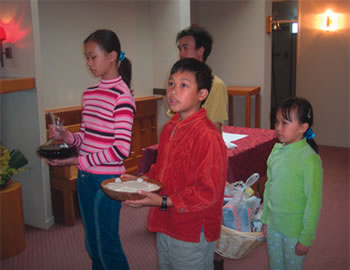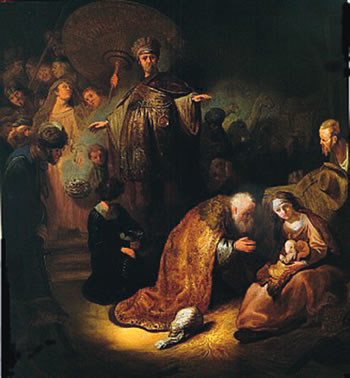The Preparation of the Gifts
Even though the faithful no longer bring from their own possessions the bread and wine intended for the liturgy as in the past, nevertheless the rite of carrying up the offerings still retains its force and its spiritual significance. It is well also that money or other gifts for the poor or for the Church, brought by the faithful or collected in the church, should be received. General Instruction of the Roman Missal 73.
There is a description of the papal mass at Saint Mary Majors in about 700 AD, which includes the line “The Pope and his attendants then go down to the people to receive the offerings, loaves of bread and flasks of wine.” (Ordo Romanus 1) This is the first clear reference to the ‘rite of carrying up the offerings’ and you can picture the Holy Father and his attendants being handed freshly baked loaves and flasks of fine wine – gifts that, during the Eucharistic Prayer, would be offered to God the Father, through the Son, in the Holy Spirit.
We know from Saint Paul’s first letter to the Corinthians that Christians used to bring food along to their celebration of the Lord’s Supper and that it was shared amongst them. Saint Paul instructs “When you assemble together to eat, be attentive to one another.” (1Cor 11:33) A concern for the poor is integral to the dynamic of table-sharing. The bread and wine for the eucharist and the gifts for the poor and for the Church belong together.
Nowadays the bread and wine are special, church-supplied items. The practice of using the ordinary bread and wine of the faithful clashed with the growing reverence and respect for the Eucharistic elements. The bread and wine were to be of high quality and the best way for the church to be sure of this was for their production to be under clerical control. Around 800 AD, Theodulf, the bishop of Orléans in France, wrote to his priests to see to it “that the breads which they offer to God in the Sacrifice be made by themselves or their servants with all care and cleanliness.” Influenced by the Old Testament, the Venerable Bede went further and recommended that unleavened bread should be used for the eucharist thereby distinguishing the Eucharistic bread from ordinary loaves.
The General Instruction speaks of the ‘force’ of this rite, and there is a power to a procession of gifts. The act of carrying something from the back of the church to the front, where it is awaited and solemnly received, draws attention to those gifts and signals that, symbolically at least, they come from those assembled. It connects the congregation to what is going to take place on the altar.
The spiritual significances which are carried by that procession are many, I will draw attention to only one. An archaeological dig at the Greek city of Delphi found some bread stamps from the seventh century. When they baked a loaf to take to church for the eucharist, they marked it as special by stamping a symbol or scene into it. The stamp illustrated in the photo shows a representation of the Magi taking gifts to the Christ-child. The Christians of Delphi understood their rite of carrying up loaves and wine to be tribute to the King of Kings, just as the Magi had presented the Christ with gold, frankincense and myrrh.




 Entries(RSS)
Entries(RSS)